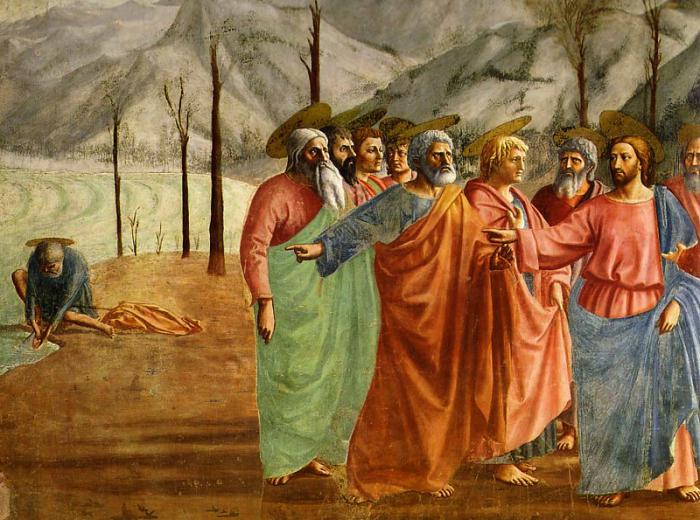Italians have always been one of the most striking and significant representatives of different areas of art - from painting to architecture. Quattrocento is the most famous period in the history of Italian culture. The Italian Masaccio is a representative of this era and deserves attention for many reasons.
early years
A Florentine artist named Tommaso di Giovanni di Simone Kassai became famous under the pseudonym Masaccio. The future great painter was born in the small town of San Giovanni Valdarno, near Florence, on December 21, 1401. His childhood was not too happy - the boy was only five years old when his father died. The head of the family was only 27 years old. The owner of a small hotel, the mother of Masaccio, got married again - the local pharmacist became her new chosen one. When Tommaso was sixteen, his stepfather died. So he became the main breadwinner. Contemporaries note that Tommaso was distinguished by a surprisingly soft and kind character, but was not too attentive to comfort and his clothes, which is why he was nicknamed clumsy - this is what the pseudonym Masaccio means in Italian.
Start date
At seventeen, he went to study painting in Florence. There are different opinions about who became his mentor. Some historians believe that he studied under Mariotto di Cristofano and Masolino da Panicale, but such a theory does not find confirmation in the chronology and technique of Tommaso - his work does not bear a trace of their influence. It is much more likely that he became a student of Bicci di Lorenzo, and also talked a lot with Donatello and Brunelleschi, the greatest masters of sculpture and architecture of those times.
Career heyday and death
In 1424, Masaccio paintings gained real popularity. The artist became a member of the Guild of St. Luke, an organization uniting Florentine masters, and began to collaborate with Masolino. The latter was very famous - his contemporaries liked his technique, and the style of aristocratic Gothic with elegant religious fabulousness was one of the key for the first half of the fifteenth century, so cooperation with him was luck for Masaccio. The paintings of the young apprentice influenced the work of the famous master Mazolino - a unique situation when a student changed the teacher’s working style. Unfortunately, the talented Florentine was not destined to live long - like his father, Tommaso died at the age of 27. The cause of death is unknown - the assumption of the historian Vasari about possible poisoning was subsequently refuted, and other documents about this event were not preserved. It is only known that this happened in Rome and that fellow artists considered this a crushing loss - the corresponding mark can be found in Brunelleschi's notes.

Work in collaboration with Mazolino
During apprenticeship, the more famous Florentine appeared the most famous paintings of Masaccio. For example, the painting “Madonna and Child with St. Anne,” about which disputes still do not cease, experts find it difficult to establish who is the author to a greater extent. The painting was created around 1424 for the church of Sant'Ambrogio. According to art historian Roberto Longa, Masolino created most of the picture. Masaccio portrayed the Madonna and child and the right angel supporting the curtain, and the remaining parts belong to the brush of his teacher, who ordered the canvas. The original feature of the work is a new composition. The finds of Masaccio can be traced in the incredible spatial depth and unusual positions of the bodies.
The artist’s works in the mural technique
The most respected contribution to the art of Masaccio in Florence, whose paintings were a breakthrough in the art of those times, was made in a fresco style. They became the basis of his legacy. The best paintings of Masaccio with the names “Baptism of the New converts” and “The Miracle with the Statier” were made for the chapel of Santa Maria del Carmine. They were ordered by the famous Florentine Felice Brancacci. The condition of the frescoes worsened significantly during the fire of 1771, but in 1988 they were restored, and now they can be seen in their original form.
A special mention deserves Masaccio's painting "Expulsion from Paradise." It was for the first time depicted a human body with the correct anatomical details. People used to be depicted with feet not touching the ground. He portrayed Eve and Adam Masaccio in a completely different way. The paintings “Miracle with a statier” and “Madonna tickling a baby” also portray people quite realistically, their composition is filled with dynamics and looks very convincing. In addition, in the first, the painter violated yet another canon - the scenes of what is happening do not go one after another, although everything remains obvious. An amazing sense of perspective and the ability to create voluminous airspace was not the last reason why Masaccio, whose paintings delight people even now, is considered one of the main creators of Quattrocento.